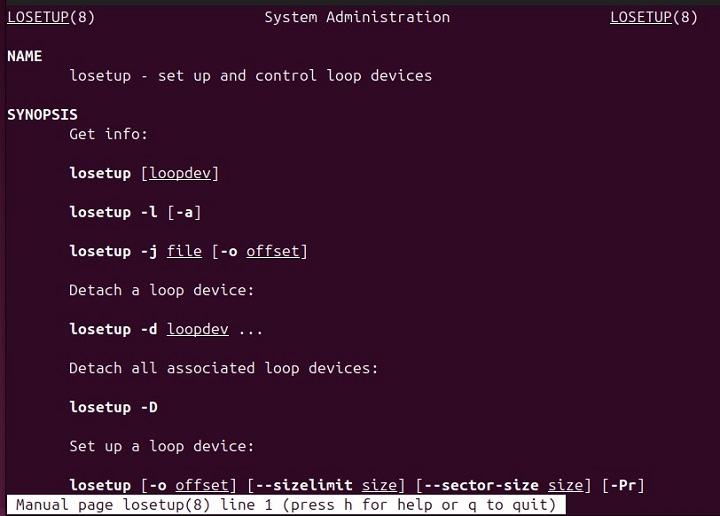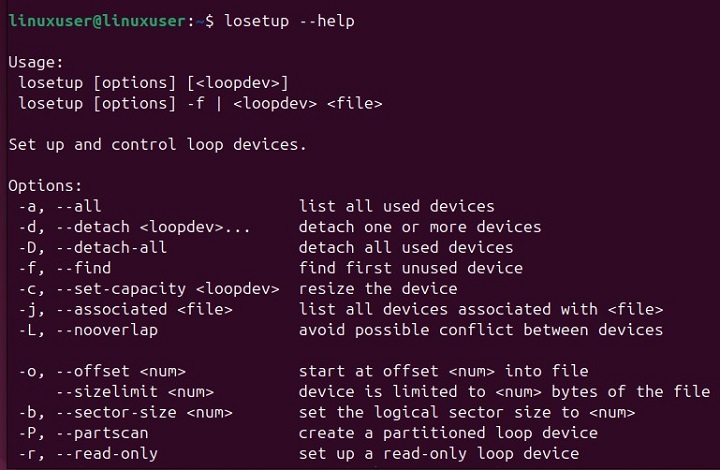
losetup Command in Linux
The losetup command lets you link loop devices with regular files or block devices, detach loop devices, and check the status of a loop device. If you provide only the loop device as an argument, it shows the status of that specific device.
The losetup command returns 0 if it runs successfully and a nonzero value if it fails. When checking a loop device's status, losetup returns 1 if the device isn't set up, and 2 if there was an error that prevented it from reading the device's status.
In this tutorial, we'll explore several practical examples to understand the use of the losetup command in Linux.
Table of Contents
Here is a comprehensive guide to the options available with the losetup command −
- What is losetup Command in Linux?
- Syntax of losetup Command
- losetup Command Options
- losetup Command Manual Page
- losetup Command Help Page
- Check losetup Command Installed Version
- Examples of losetup Command in Linux
What is losetup Command in Linux?
The losetup is a command line utility in Linux that is used to manage loop devices. Loop devices allow you to treat regular files as if they were actual disk drives. This means you can mount disk images, and files containing a complete disk copy. This way, you can access their contents as if they were physical disks.
Additionally, you can create file systems on these files, which lets you organize and store data within them. This functionality is especially beneficial when working with disk images, backup files, and various storage formats, making managing and using your data easier.
Syntax of losetup Command
We can use the following syntax to get information about loop devices −
losetup loopdev losetup -a losetup -j file [-o offset]
To delete a loop, we can use the losetup command with the following syntax −
losetup -d loopdev...
To print the name of the first unused loop device, you can use the losetup command with the -f option −
losetup -f
Similarly, we can use the following syntax to setup the loop device −
losetup [{-e|-E} encryption] [-o offset] [--sizelimit limit]
[-p pfd] [-r] {-f[--show]|loopdev} file
We can run the losetup command with the -c option to resize a loop device −
losetup -c loopdev
losetup Common Options
Let's have a look at the common options that we can use with the losetup command −
| Options | Description |
|---|---|
| -a, --all | Show the status of all loop devices. |
| -c, --set-capacity loopdev | Update the file size for a specific loop device. |
| -d, --detach loopdev | Detach the file from the specified loop device(s). |
| -e, -E, --encryption encryption_type | Enable encryption with a specified type. Encryption can be specified either by a numerical code or by name, but if you specify a number, it's essential to ensure that the Linux kernel supports that particular encryption type. |
| -f, --find | Find the first unused loop device; use it if a file is given, or print its name. |
| -h, --help | Display help page, containing concise overview of the command usage. |
| -j, --associated file | Show loop devices associated with a specific file. |
| -k, --keybits num | Set the encryption key size in bits. |
| -N, --nohashpass | Don't hash the password (Debian defaults to hashing). |
| -o, --offset offset | Start data from the specified byte offset. |
| --sizelimit size | Limit data size to the specified number of bytes from the start. |
| -r, --read-only | Set up a read-only loop device. |
| --show | Display the device name if -f and a file are used; -s (deprecated) can conflict with other implementations. |
losetup Command Manual Page
Let's type man followed by losetup to access the manual page of the command −
man losetup

losetup Command Help Page
The manual page provides a comprehensive overview of the Linux commands like losetup. However, we can get the concise information of a specific command by executing the losetup command with the --help option −
losetup --help

Check losetup Command Installed Version
Let's check the losetup version to ensure that it is properly installed on our system and to avoid compatibility issues −
losetup --version

Examples of losetup Command in Linux
You can use the losetup command to associate files with loop devices to perform various operations. Let's go through the following example for a profound understanding of the losetup usage −
Listing Loop Devices with losetup Command
Let's run the losetup command with the -a option to list all loop devices −
losetup -a

You can also run the losetup command without any argument to list all active loop devices and their associated files or block devices −
losetup

Setting Up a Loop Device with losetup
To set up a loop device, we can use the losetup command followed by the loop device name and file name −
losetup loop_device fileName
Replace loop_device and fileName with the actual loop device (e.g., /dev/loop0) and the path to the file you want to associate with it. When we run this command, fileName is linked to loop_device, which enables us to treat the file like a disk.
Detaching a Loop Device Using losetup Command
If a loop device is no longer needed, you can use the losetup command with the -d option to detach it −
losetup -d loop_device
This will free up the loop device for future use.
Finding the First Available Loop Device Using losetup
You can run the losetup command with the -f option to automatically find and use the first available loop device −
losetup -f disk_image.img
This command associate the given file with the next available loop device.
Specifying Offsets with losetup
In the same way, we can execute the losetup command with the -o option to specify a specific offset while setting up a loop device −
losetup -o offset loop_device fileName
Replace offset with the byte offset (e.g., 2048), loop_device with the loop device (e.g., /dev/loop0), and fileName with the file path (e.g., disk_image.img).
Conclusion
losetup command is a useful tool for managing loop devices in Linux. It enables users to link files or block devices to loop devices, detach them, and retrieve their status.
The losetup command is particularly useful for handling disk images and setting up encrypted file systems, with options to specify byte offsets, encryption methods, and read-only access. In this article, we discussed several examples to effectively discuss the use of the losetup command in Linux.